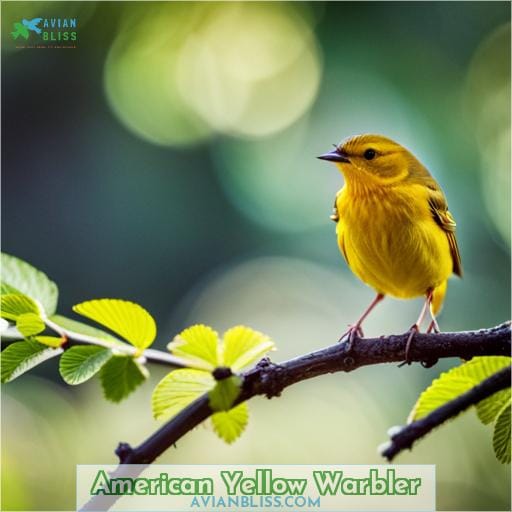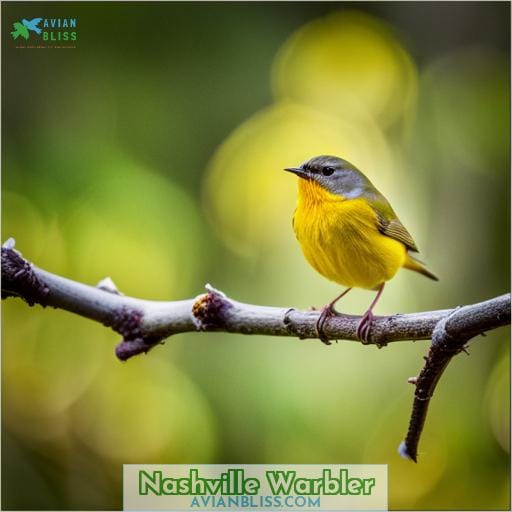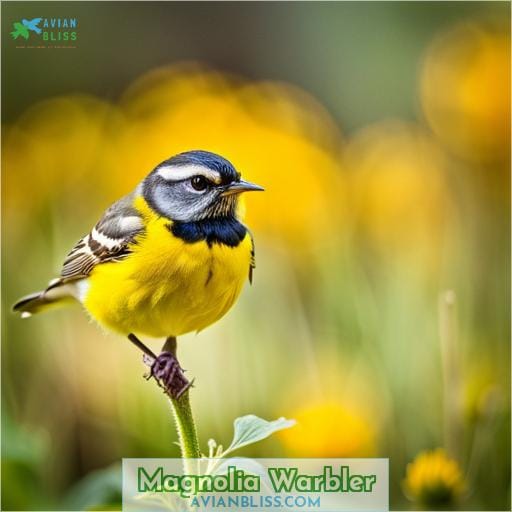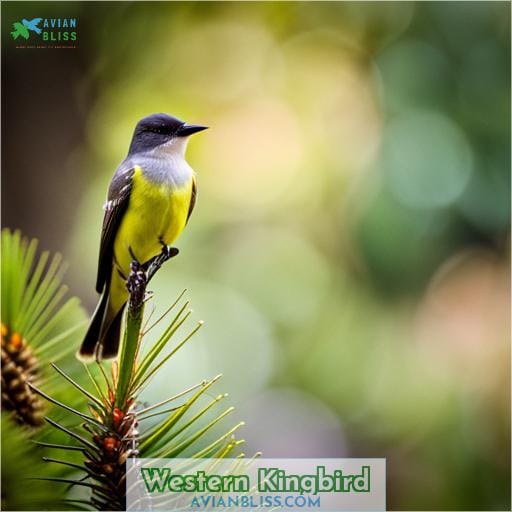This site is supported by our readers. We may earn a commission, at no cost to you, if you purchase through links.
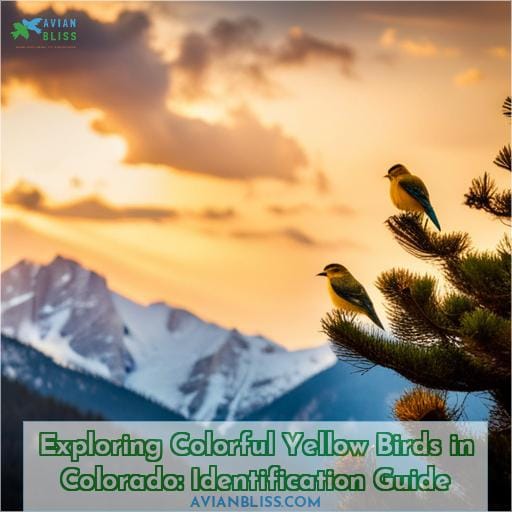 Amidst the vibrant tapestry of Colorado’s wild landscapes, a symphony of yellow feathers dances on the breeze. Each flutter is a brushstroke of brilliance against the mountainous backdrop. In the realm where azure skies meet lush valleys, you find yourself entranced by the avian residents that adorn this picturesque scenery.
Amidst the vibrant tapestry of Colorado’s wild landscapes, a symphony of yellow feathers dances on the breeze. Each flutter is a brushstroke of brilliance against the mountainous backdrop. In the realm where azure skies meet lush valleys, you find yourself entranced by the avian residents that adorn this picturesque scenery.
Here, in this high-altitude haven, a variety of yellow birds grace the land, painting the air with their vibrant hues. From the sunny glades to the whispering woods, their presence ignites curiosity and wonder in the heart of any observer.
This guide unveils a realm of feathered splendor, presenting an exquisite array of these golden-hued denizens. Whether it’s the charming American Goldfinch, the elusive Wilson’s Warbler, or the enchanting Evening Grosbeak, this is your ticket to uncovering the mysteries of yellow birds in Colorado, fostering a deep connection to the natural tapestry that envelops you.
Venture forth, fellow explorer, and let the melodies of these winged companions accompany you on your journey to belonging and understanding in the realm of these captivating creatures.
Table Of Contents
- Key Takeaways
- American Goldfinch
- Wilson’s Warbler
- American Yellow Warbler
- Yellow-Rumped Warbler
- Nashville Warbler
- Evening Grosbeak
- Yellow-Breasted Chat
- Magnolia Warbler
- Yellow-Headed Blackbird
- Western Kingbird
- Frequently Asked Questions (FAQs)
- What is the distinctive call or song of the American Goldfinch, and how can I differentiate it from other similar yellow birds in Colorado?
- How does the migration pattern of the Yellow-Rumped Warbler vary between its breeding and wintering locations, and what factors influence this seasonal movement?
- In what ways does the plumage of the Nashville Warbler change during its migration, and how can bird enthusiasts identify this species during both its breeding and non-breeding periods?
- Among the mentioned yellow birds, what unique environmental factors or conditions prompt the Evening Grosbeak to venture into open areas with fruiting shrubs during the winter, compared to its preference for northern forests during the breeding season?
- Conclusion
Key Takeaways
- Vibrant yellow feathers adorn Colorado’s wild landscapes, creating a stunning contrast against the backdrop of majestic mountains.
- Various species of yellow birds find their home in Colorado’s high-altitude haven, adding to the state’s avian diversity.
- Colorado is home to fifteen species of yellow birds, each contributing to the state’s rich avian tapestry.
- Observing yellow birds offers a unique glimpse into the interconnectedness and beauty of nature.
American Goldfinch
Nestled within Colorado’s vibrant avian tapestry, the American Goldfinch stands as a captivating emblem of the state’s diverse birdlife. With its striking yellow plumage punctuated by a distinctive black cap, this finch’s presence is artistically marked across the state’s forest edges, plains, and brushy landscapes.
The Cornell Lab of Ornithology’s range map elegantly traces the Goldfinch’s widespread prevalence, a testament to its enchanting allure in the Centennial State’s natural mosaic.
Prevalence in Colorado
As you explore the diverse habitats of this captivating region, a vibrant array of golden-feathered inhabitants emerges, from the wooded edges to the open plains, each showcasing the brilliance of nature’s palette against the backdrop of the Rocky Mountain landscapes.
Delighting both ear and eye, American Goldfinches bring their melodious songs and sunny plumage to Colorado.
-
Habitat Preferences: These charming songbirds favor forest edges, plains, and areas adorned with thistles, offering a harmonious blend of color and sound.
-
Migration Patterns: Some Goldfinches migrate south during the winter, forming lively flocks that grace the skies with their cheerful presence.
-
Nesting Behaviors: Their intricate nests, woven with plant fibers and positioned high in trees, reveal their dedication to creating secure homes for their young.
-
Attracting Strategies: To welcome these yellow beauties, provide sunflower seeds, water sources, and cozy nesting sites, inviting their delightful company to your backyard sanctuary.
Range Map
Explore the vivid expanse of their habitats through captivating range maps, tracing enchanting creatures’ paths across Colorado’s landscapes. Witness the dynamic migration patterns of yellow-rumped warblers and yellow warblers as they navigate these regions during summer.
Marvel at plumage variations that help these birds thrive in diverse ecosystems. Discover their intricate nesting behaviors and the strategies you can employ to attract these captivating yellow birds to your own corner of Colorado.
Wilson’s Warbler
Moving from the vibrant presence of the American Goldfinch, let’s delve into the world of Wilson’s Warbler.
As you explore Colorado’s bird diversity, the Wilson’s Warbler is a gem to discover. This petite songbird, measuring 11-13 cm, flaunts its sunny disposition with mostly yellow plumage accentuated by a distinct black cap on males.
What’s fascinating is its habitat preference – the warbler finds solace in mountain meadows and thickets alongside babbling streams. With an affinity for insects and a taste for some fruits, the Wilson’s Warbler unveils its feeding habits with energetic foraging.
In the warmer months, watch for their arrival as they embark on migratory journeys. These little travelers, known for their melodious vocalizations, exhibit nesting behaviors that highlight their affinity for cozy, verdant spots.
As you bask in the colorful tapestry of Colorado’s birdlife, the Wilson’s Warbler adds its vibrant brushstroke, an embodiment of nature’s symphony.
American Yellow Warbler
Imagine strolling through lush, vibrant gardens and being serenaded by the melodious songs of a small, lemon-hued songbird—the American Yellow Warbler. With its cheerful plumage and distinct chestnut streaks on its chest, it brings a touch of sunny elegance to the serene landscapes of this region.
This delightful bird measures 12.5-13 cm and exhibits fascinating nesting behaviors. It crafts intricate, cup-shaped nests in bushes, swamp edges, streams, and gardens, using materials like grass, leaves, and spider silk.
During the breeding season, its sweet, musical notes fill the air, marking its territory and attracting potential mates.
The American Yellow Warbler is also a remarkable migratory species. Every spring and fall, these birds embark on remarkable journeys, traveling thousands of miles between their breeding and wintering habitats.
As they traverse vast distances, their vibrant plumage shines like a beacon against the backdrop of varied landscapes. It’s a sight that captures the essence of freedom and adventure, invoking a sense of belonging to the natural world.
So, as you immerse yourself in the enchanting world of Colorado’s bird species, keep an ear out for the bright melodies and a watchful eye on the sunny elegance of the American Yellow Warbler.
Yellow-Rumped Warbler
Identifying a distinctively marked passerine known for its rump patch, the Yellow-Rumped Warbler, or Setophaga coronata, stands out amidst the diverse avian inhabitants of Colorado with its gray plumage and conspicuous patch of vibrant color.
This small yet captivating bird exhibits intriguing behavior, showcasing its adaptability through seasonal movements and plumage variations. The Yellow-Rumped Warbler‘s melodic vocalizations add to the symphony of Colorado’s birdlife, often heard as it forages among the branches.
With a diverse feeding ecology, it contributes to the delicate balance of the ecosystem by consuming insects, thus playing a vital role in pest control.
Birdwatching enthusiasts and nature lovers in Colorado are treated to the enchanting presence of the Yellow-Rumped Warbler, a remarkable avian species that adds a touch of allure to the state’s scenic landscapes.
Nashville Warbler
Transitioning from the vibrant Yellow-Rumped Warbler, let’s turn our attention to another enchanting avian resident of Colorado: the Nashville Warbler. As spring sweeps across the region, these cheerful warblers embark on their remarkable migration patterns, drawing attention with their striking appearance and lively vocalizations.
During the breeding season, the Nashville Warbler finds its haven in the mountain meadows and lush thickets near Colorado’s pristine streams. Their presence adds a harmonious melody to the symphony of nature. These small wonders are known for their affinity for insects and the occasional indulgence in juicy berries.
While their habitat diversity includes forests and shrubs, they particularly thrive in orchards and gardens, sharing the landscape with other yellow-hued companions like the Yellow Warblers and even the vibrant Summer Tanagers.
Truly, the Nashville Warbler’s contribution to Colorado’s avian tapestry is a testament to the dynamic beauty and freedom of nature.
Nashville Warbler Highlights:
- Spring Migration Patterns: Captivating journeys across Colorado’s landscapes.
- Breeding Behaviors: Finding solace in mountain meadows and thickets.
- Melodious Vocalizations: Adding a delightful chorus to the natural symphony.
- Feeding Preferences: A taste for insects and delectable berries.
- Habitat Diversity: From forests to orchards, a versatile inhabitant of Colorado’s wilds.
Evening Grosbeak
Captivating with its vibrant plumage and distinct markings, the Evening Grosbeak graces the forests of Colorado. Its yellow and black hues blend harmoniously with the wild surroundings. This remarkable songbird, sized comparably to a robin, boasts a stunning combination of bright yellow and contrasting black and white patches on its wings.
Its melodious nocturnal trills add a mysterious charm to the Colorado wilderness. During the day, it forages for seeds and insects. The Evening Grosbeak’s intriguing breeding patterns and range expansion further enhance its allure.
It has been steadily increasing its presence in the region over recent years. As you explore the enchanting landscapes of Colorado, keep an attentive ear and eye out for this captivating species.
| Trait | Description |
|---|---|
| Size | Robin-sized |
| Plumage | Vibrant yellow, black and white accents |
| Behavior | Nocturnal vocalizations, diurnal foraging |
| Range Expansion | Increasing presence in Colorado |
| Breeding Patterns | Breeds in coniferous forests |
| Feeding Habits | Seeds and insect diet |
Yellow-Breasted Chat
Sure, you’ll find it fascinating that the Yellow-Breasted Chat, with its olive-gray plumage and vibrant yellow breast, has a lifespan of around 5 to 8 years, making it a remarkable addition to the diverse avian population in the region.
This elusive bird thrives in thickets and grassy areas adorned with bushes and shrubs, where it showcases its lively behaviors. Renowned for its melodious and varied vocalizations resembling a medley of different bird songs, the Yellow-Breasted Chat is a true songster of the wild.
During breeding, it builds intricate cup-shaped nests, often well-hidden among vegetation. Its feeding ecology includes a mix of insects and small fruits, contributing to its robust lifestyle.
The Yellow-Breasted Chat stands as a symbol of nature’s harmonious tapestry, capturing the essence of freedom and unity within Colorado’s avian realm.
Magnolia Warbler
Explore the unique charm of the Magnolia Warbler as it graces Colorado’s landscape with its striking striped pattern of yellow, black, and white, making it an exceptional sight among the vibrant avian residents.
-
Migration Mastery: The Magnolia Warbler embarks on an impressive migration journey, covering vast distances between its breeding grounds in northern North America and its wintering habitats in Central and South America. This remarkable feat showcases its adaptability and survival skills.
-
Breeding Habits: During the breeding season, these warblers find their homes in mature conifer woods, where they skillfully build cup-shaped nests in the lower branches. Males sing melodious songs to attract females, creating a harmonious atmosphere amidst the trees.
-
Diverse Diet: While primarily insectivorous, the Magnolia Warbler also includes berries and fruits in its diet, especially during migration. This versatile feeding behavior allows it to thrive in various environments and maintain its energy levels.
-
Conservation Status: The Magnolia Warbler holds a conservation status of Least Concern, owing to its stable population and widespread habitat range. Conservation efforts continue to focus on preserving its habitats and raising awareness about the importance of maintaining biodiversity.
Witnessing the Magnolia Warbler’s vibrant plumage and observing its distinctive behaviors provides an enriching connection to the natural world, echoing the shared desire for belonging, understanding, and the freedom to explore the wonders of nature.
Yellow-Headed Blackbird
With its vibrant face as bright as the sun and its striking contrast between the vivid hues and the dark plumage, the Yellow-Headed Blackbird emerges as a captivating emblem of wetland habitats. It makes its presence known among the reeds and cattails. This remarkable bird boasts a size of 20-25 cm and a vibrant yellow face that contrasts dramatically with its black wings, beak, and eyes.
It can be found in gardens, thickets, and forests, and its diet consists of seeds, insects, and berries, contributing to its splendid diversity. Notably, its lifespan can reach up to 18 years, granting ample time to observe its unique behaviors.
From its intricate breeding rituals to its vocalizations that resonate across marshes, the Yellow-Headed Blackbird intertwines a sense of belonging, understanding, and freedom with the rich tapestry of Colorado’s wetlands.
Western Kingbird
As you venture across open landscapes, imagine a lemon-yellow belly catching the sunlight from high perches – the Western Kingbird stands out with its vibrant plumage and insect-hunting prowess. This charismatic bird, with its sleek body and keen presence, exhibits fascinating behaviors that draw you into its world.
-
Nesting Habits: The Western Kingbird constructs its cup-shaped nests on horizontal branches, often choosing locations near fields or water sources.
-
Vocalizations: Its calls and songs are a mix of high-pitched chattering and sharp kip sounds, a symphony that echoes across its habitat.
-
Migration Patterns: During migration, these kingbirds travel impressive distances, crossing vast expanses in search of food and breeding grounds.
-
Feeding Preferences: Known for its agile flight, the Western Kingbird dines primarily on insects caught mid-air, showcasing its aerial acrobatics.
In the presence of this bird, you’re reminded of the interconnectedness of life in nature – the quest for sustenance, the annual journey, and the harmonious melodies that fill the air.
Frequently Asked Questions (FAQs)
What is the distinctive call or song of the American Goldfinch, and how can I differentiate it from other similar yellow birds in Colorado?
To differentiate the American Goldfinch’s song from its vibrant yellow counterparts, remember its allusion: a joyful, fluid tune that cascades like laughter, standing out among Colorado’s avian symphony, evoking a sense of belonging in nature’s embrace.
How does the migration pattern of the Yellow-Rumped Warbler vary between its breeding and wintering locations, and what factors influence this seasonal movement?
Embark on a journey through the vibrant world of Yellow-Rumped Warbler migration. From coniferous breeding havens to winter’s fruitful landscapes, these intrepid travelers are guided by instinct and environmental cues, embracing the rhythm of nature’s dance.
In what ways does the plumage of the Nashville Warbler change during its migration, and how can bird enthusiasts identify this species during both its breeding and non-breeding periods?
During migration, the Nashville Warbler undergoes a transformation in its appearance. In its breeding plumage, it displays an olive-green back and a distinctive white eye ring. However, during the winter, it adopts a more subdued look with a pale yellow underbelly.
Among the mentioned yellow birds, what unique environmental factors or conditions prompt the Evening Grosbeak to venture into open areas with fruiting shrubs during the winter, compared to its preference for northern forests during the breeding season?
Like a wanderer seeking diverse landscapes, the Evening Grosbeak migrates to open areas with fruiting shrubs during winter, contrasting its forest haven in the breeding season.
Conclusion
Dive into the vibrant avian tapestry of Colorado, where yellow birds grace the landscape with their vivid hues.
This array of avian beauty, from the iconic American Goldfinch with its distinctive black cap to the elusive Wilson’s Warbler adorned in greenish-yellow, adds an enchanting touch to Colorado’s diverse ecosystems.
Exploring these winged wonders is like embarking on a treasure hunt. In the serene forests, you might spot the lemon-yellow American Yellow Warbler flitting among the willow groves, or the striking Yellow-Rumped Warbler, its gray plumage contrasting with its telltale rump patch, gracing the coniferous woodlands.
But it’s not just their colors that captivate; it’s their behaviors too. Watch the Evening Grosbeak, with its yellow and black attire, displaying its strong beak while foraging for seeds and insects in the northern forests.
And don’t forget the elegant Western Kingbird, perched regally on high points, revealing its vibrant lemon-yellow belly and aerial insect-catching prowess.
So, whether you’re a seasoned birdwatcher or just beginning to explore the world of ornithology, Colorado offers an enchanting array of yellow birds that will captivate your senses. From the stunning American Goldfinch to the elusive Wilson’s Warbler, these feathered wonders are waiting to be discovered against the backdrop of Colorado’s breathtaking landscapes.
So, set out with your binoculars and guidebook, and embark on a journey to witness the lively symphony of yellow birds in Colorado’s great outdoors.


